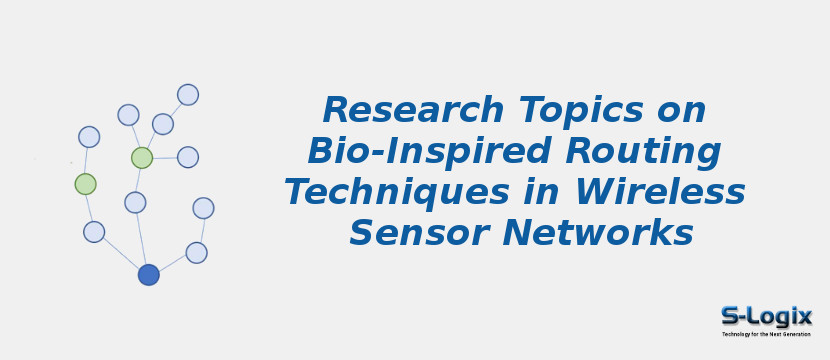Bio-inspired routing techniques in wireless sensor networks are inspired by the behavior and communication patterns of animals in a colony. These techniques improve communication efficiency and reliability in large-scale wireless sensor networks. Some examples of bio-inspired routing techniques include:
• Bee algorithm (BA): This technique uses the communication patterns of bees in a colony to find an optimal solution to a multi-objective optimization problem.
• Ant colony optimization (ACO): This routing technique uses the foraging behavior of ants to find the shortest path between a source and a destination node in a network.
• Particle swarm optimization (PSO): This technique models the behavior of birds flocking and uses their collective intelligence to find an optimal solution in a network.
These bio-inspired routing techniques address routing challenges in wireless sensor networks, such as congestion, energy efficiency, and network scalability.
• Energy Efficiency: Bio-inspired routing algorithms optimize the energy consumption of nodes in a network, leading to an extended network lifetime and increased energy savings.
• Simplicity: Bio-inspired routing algorithms are relatively simple to implement and do not require complex mathematical models or algorithms, making them easy to deploy in real-world wireless sensor networks.
• Scalability: These techniques can handle large-scale wireless sensor networks, making them suitable for applications with many nodes deployed.
• Robustness: Bio-inspired routing algorithms are designed to adapt to changes in network conditions and can recover from network failures, making them robust and reliable.
• Load balancing: These techniques can effectively distribute network load, reducing congestion and improving performance.
• Multi-objective optimization: Bio-inspired routing algorithms can optimize performance metrics such as energy consumption, network lifetime, and communication reliability, providing a more comprehensive solution to routing challenges in wireless sensor networks.
• Complexity: Some bio-inspired algorithms can be computationally complex, requiring significant computational resources and increasing network latency.
• Lack of rigor: Bio-inspired algorithms are often designed based on heuristics and do not always guarantee optimality, making them less rigorous and predictable than traditional routing algorithms.
• Sensitivity to parameters: Bio-inspired algorithms often rely on various parameters to control their behavior, and selecting these parameters can significantly impact their performance.
• Limited applicability: Bio-inspired algorithms are designed for specific network scenarios and may not apply to all wireless sensor networks.
• Difficult analyze: The behavior of bio-inspired algorithms can be difficult to analyze and understand, making it challenging to predict their performance in different network conditions.
• Convergence speed: Some bio-inspired algorithms may take a long to converge to an optimal solution, making them unsuitable for real-time or time-critical applications.
Bio-inspired routing techniques in wireless sensor networks have a wide range of applications, including:
• Environmental monitoring: Wireless sensor networks can be used to monitor the environment for various parameters, such as temperature, humidity, and air quality, and bio-inspired routing techniques can be used to optimize communication and data dissemination in these networks.
• Industrial automation: Wireless sensor networks can be used in industrial automation applications, such as monitoring and control of production processes, and bio-inspired routing techniques can be used to optimize communication and data dissemination in these networks.
• Disaster response: Wireless sensor networks can be deployed in disaster-stricken areas to monitor and respond to various parameters, such as temperature, humidity, and air quality, and bio-inspired routing techniques can be used to optimize communication and data dissemination in these networks.
• Healthcare: Wireless sensor networks can be used in healthcare applications, such as remote patient monitoring, and bio-inspired routing techniques can optimize communication and data dissemination in these networks.
• Agriculture: Wireless sensor networks can be used in agriculture to monitor various parameters, such as soil moisture, temperature, and light intensity, and bio-inspired routing techniques can be used to optimize communication and data dissemination in these networks.
• Traffic management: Wireless sensor networks can be used in traffic management systems, such as monitoring and controlling traffic flow, and bio-inspired routing techniques can be used to optimize communication and data dissemination in these networks.
• Energy-aware routing: Developing bio-inspired routing techniques to better balance energy consumption and network performance.
• Multi-objective optimization: Developing bio-inspired routing techniques that optimize multiple performance metrics, such as energy consumption, network lifetime, and communication reliability.
• Integration with other technologies: Integrating bio-inspired routing techniques with other technologies, such as machine learning and edge computing, to enhance network performance.
• Network security: Developing bio-inspired routing techniques that can provide enhanced security in wireless sensor networks, such as defending against attacks and detecting intrusions.
• Dynamic network management: Developing bio-inspired routing techniques that can dynamically adapt to changes in network conditions and improve network performance.
• Real-time performance: Improving the real-time performance of bio-inspired routing techniques and making them more suitable for time-critical applications.
• Scalability: Developing bio-inspired routing techniques that scale to large-scale wireless sensor networks.
There are many potential research topics in the field of bio-inspired routing techniques in wireless sensor networks, some of which include:
• Multi-objective optimization: Developing bio-inspired routing algorithms to optimize multiple performance metrics, such as energy consumption, network lifetime, and communication reliability.
• Network security: Developing bio-inspired routing algorithms that can provide enhanced security in wireless sensor networks, such as defending against attacks and detecting intrusions.
• Network coverage optimization: Developing bio-inspired routing algorithms improve network coverage and reduces the number of nodes required to achieve a desired level of coverage.
• Data dissemination optimization: Developing bio-inspired routing algorithms optimize data dissemination in wireless sensor networks.
• Real-time performance optimization: Improving the real-time performance of bio-inspired routing algorithms and making them more suitable for time-critical applications.
• Network self-organization: Developing bio-inspired routing algorithms that can dynamically adapt to changes in network conditions and improve network performance.
• Integration with other technologies: Integrating bio-inspired routing algorithms with other technologies, such as machine learning and edge computing, to enhance network performance.
